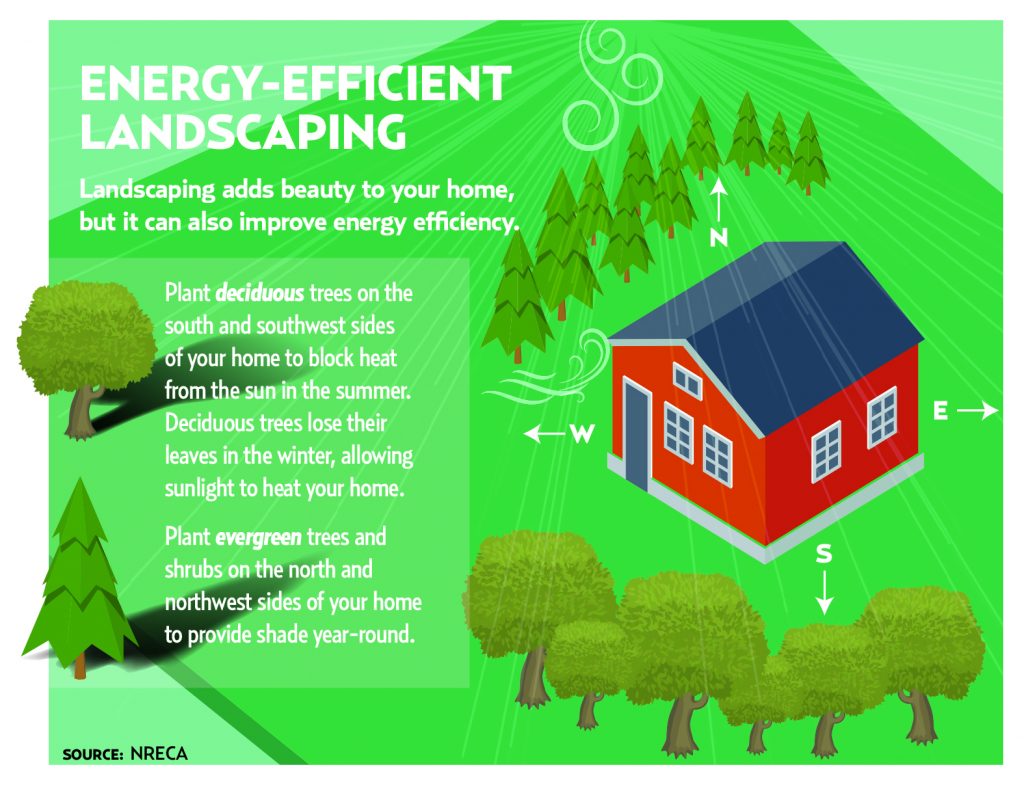By Patrick Keegan and Amy Wheeless
Late winter and early spring are great times to think about changes to your home’s landscape. While the goal of most lawn and garden projects is to bring beauty to your outdoor space, a well-designed project can also save energy, increase the overall value of your home and provide additional benefits, such as reduced noise pollution, optimized water use and cleaner air around your home.
Summer shading
Shading your home is the most cost-effective way to reduce heat gain from the sun and reduce your air conditioning costs in the summer, says the U.S. Department of Energy. Having more plants and trees in your yard can reduce the air temperature by up to 6 degrees F.
Planting deciduous trees on the south, southwest and west sides of your home can cut heating during hot summer months, while allowing sunlight through during the fall and winter, when the trees have lost their leaves. When planting trees, consider the expected shape and height of the mature trees and where they will shade your home. A tree with a high mature height planted on the south side of a home, for example, will provide all-day roof shading in the summer, while a lower tree on the west side can protect your home from the lower afternoon sun.
Plant trees an appropriate distance away from your home so they do not disrupt your foundation or your roof as they grow. While it will be five to 10 years before a newly planted tree begins providing shade to your roof, it can start shading windows immediately. Incorporate other plants to provide near-term shade. Shrubs, bushes and vines can quickly shade windows and walls.
Also consider any paved areas around your home and how to shade them during the summer. Think about walking across your driveway barefoot on a hot July afternoon — if your driveway or patio is unshaded, it is probably quite difficult. That absorbed heat is also reflecting onto your home, causing your air conditioner to work even harder. Use trees, hedges and other landscaping structures such as arbors to shade these paved areas.
Wind-blocking techniques
If your home is in an open area without many structures around it, cold winter winds may be increasing your heating bills. A windbreak on your property can help deflect these winds over your home. The most common type of windbreak uses a combination of conifer (evergreen) trees and shrubs to block wind from the ground to the top of your home. For the best windbreak effect, plant these features on the north and northwest sides of your home at a distance of between two and five times the height of the mature trees. Incorporating a wall or fence can further assist with the wind break.
Regardless of where you are, if you live near power lines, talk with your electric co-op about how far away newly planted trees should be from these lines before making any final design decisions to your yard.

Patrick Keegan writes on consumer and cooperative affairs for the National Rural Electric Cooperative Association, service arm of the nation’s 900-plus consumer-owned, not-for-profit electric cooperatives based in Arlington, Virginia. Amy Wheeless writes for Collaborative Efficiency. For more information, visit:www.collaborativeefficiency.com/energytips or email Pat Keegan at energytips@collaborativeefficiency.com.



